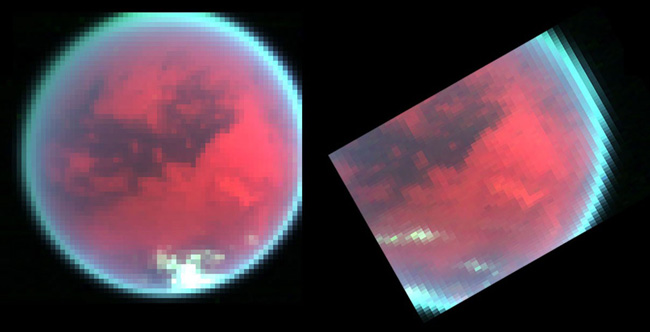The 30-Year Forecast: Predicting Titan's Clouds

Using a new climatepredicting model, scientists can predict cloud formation on Titan 30 years intothe future.
That may sound like a longrange forecast, but 30 Earth years correspond to just one year on Titan, Saturn's largest moon.
The new computer model,however, will help scientists predict where and when large seasonal clouds will appear and disappear acrossthe moon, enabling them to plan productive future observations of the hazymoon.
While the Cassini spacecraft has provided stunning images and near-infraredscans of Titan's clouds, until now scientists couldn't say for sure how theethane/methane clouds form. The new general circulation model, however,combines haze circulation and cloud physics to help solve the riddle.
The model matches past andpresent observations, and researchers expect it to accurately forecast whereclouds will pop up in the future.
Unlike previously proposedmodels, the new model has the advantage of being teamed up with Cassini images to confirm its accuracy. Taken together,scientists have determined that Titan's clouds form and move much like those onEarth and Mars.
"Consistently, ourmodel produces clouds at places where clouds are actually observed," saidstudy leader Pascal Rannou of the Service d'Aeronomie, IPSL Universite deVersailles-St-Quentin, France. "But it also predicts clouds that have not,or not yet, been observed."
Get the Space.com Newsletter
Breaking space news, the latest updates on rocket launches, skywatching events and more!
The research is detailed inthe Jan. 13 issue of the journal Science.
Earth-like cloud engine
Titan's atmosphere, likethose at Earth and Mars, is a thermodynamic engine--warm air moves towards coolair and stirs things up in between. Warm air is generally found near theequator of a planet, where it rises into the upper atmosphere and driftstowards the poles, the coolest region of the orb.
As the air reaches higheraltitudes and polar latitudes, the drop in temperature causes any moisture tocondense into clouds.
Clouds form at the poles,however, simply because the air is cool enough for condensation. Currently,scientists can only confirm the presence of clouds at Titan's southern pole.However, they expect to find similar clouds up north when that pole comes intoview, probably in 2010.
On Earth and Mars, cloudscondense in the tropics, around 30 degrees North and South. Titanic clouds forminstead around 40 degrees and stretch to 60 degrees. Scientists aren't quitesure what drives this difference, but believe Saturn's tidal effects might playa role.
Season in the Sun
The model forecasts 30Earth years into the future, but since that time equals one year on Titan, Rannou believes the cloud formation patterns followseasonal trends. Clouds appear in Titan's southern hemisphere during the summerseason. But during the southern winter, they follow summer to the northernhemisphere.
"On Titan, the cloudsappear in the summer time. This is opposite from Earth--when we have summer inthe southern hemisphere, clouds are transferred to the north," Rannou told SPACE.com. "We should spend all ourdays in winter on Titan, compared to Earth."
The model predicts that inthe next few years, the mid-latitude clouds around 40 degrees south will movenorthwards. The clouds would likely return to the south in 2015.
"If cloud formation isreally due to air circulation, this is what it will do," Rannou said.
Model upgrade
The new model producesaccurate cloud forecasts by taking into account the circulation of the moon'shaze. Haze circulation affects where on the moon the columns of warm air willrise and form clouds.
Also, the new model makespredictions in two dimensions, Rannou said, anupgrade over earlier one-dimensional predictions. However, having only twodimensions raises questions about what goes on in the vertical layers.
"In the near future weplan to improve it to be three-dimensional, providing a complete circulationmodel," Rannou said.
- Traveling to Titan? Here's what to expect
- Titan: A World of Its Own
- Touchdown on Titan: Huygens Probe Hits its Mark
- Detailed Photos Reveal Clouds on Saturn's Moon Titan
- Smog on Saturn's Moon Titan Reveals Weather Patterns
Join our Space Forums to keep talking space on the latest missions, night sky and more! And if you have a news tip, correction or comment, let us know at: community@space.com.









